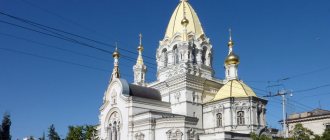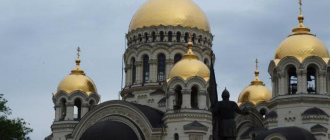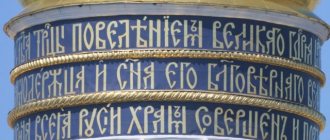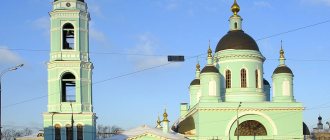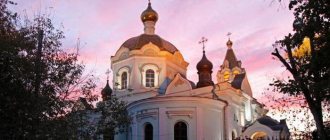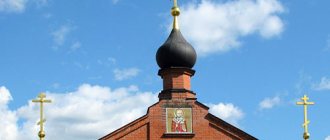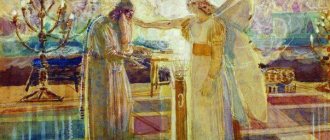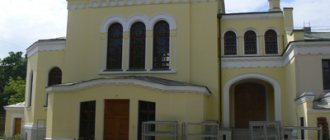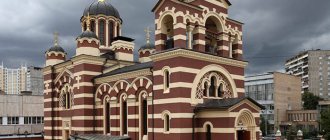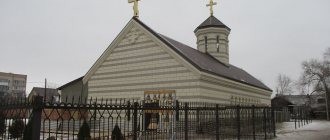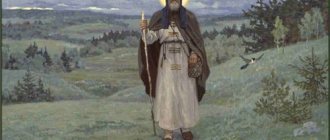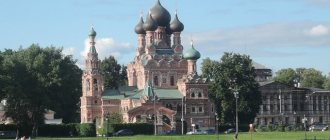The Church of St. Sergius of Radonezh on Khodynskoye Field has often become the subject of controversy and even land scandals in recent years. But worldly affairs calmed down, and on Christmas Day 2022, the first liturgy was held in the church, which had not yet completed construction. The authorities promise that the temple will be completely restored by the fall of this year. All this causes increased interest in the church on Khodynskoye Field. When was it built and why? When and why was it demolished? Does the current temple correspond to its original appearance? We will talk about this in our article. We will also provide general information on how to get to the temple complex and the schedule of services. We will briefly touch on the vicissitudes associated with the restoration of the church.
Temple of St. Sergius of Radonezh on the Khodynka Field: history
To understand the purpose of the original church, you need to understand that previously chaplains were required to serve in military units. Even in an open field, before a battle, they laid out a marching altar in front of the assembled soldiers and held a liturgy. In the nineteenth century, Khodynskoye Field was located outside the city. In warmer times, soldiers were transferred there for drill. The so-called summer barracks were built there. What about soldiers without worship services? Therefore, every summer a tent was erected in which an altar was installed. Near this camp chapel, a column with bells was driven into the ground.
The need to build a full-fledged church appeared in the eighties of the last century, when the number of soldiers reached thirty thousand. The tent could no longer accommodate everyone who wanted to listen to the liturgy. In May 1883, a parade was held on Khodynka Field, which was hosted by the Emperor. After this, the military command decided to build a church in honor of this event, consecrating it in honor of St. Sergius of Radonezh. An honorary citizen of Moscow, merchant Nikolai Kaverin, undertook to contribute money for the construction of a wooden church. But the provincial government did not like the presented drawing of the structure, and it sent it for revision.
Construction of the original temple begins
There were no funds to build a more expensive project, and it was briefly forgotten. In 1891, Russian citizens were shocked by an event: an attempt was made on the life of the heir to the throne, Nikolai Alexandrovich, in the Japanese city of Otsu. The Tsarevich miraculously remained unharmed, and in honor of this memorable date, General A. Kostanda, commander of the Moscow military garrison, gave the order to build a temple of Sergius of Radonezh on the Khodynka field.
The construction was supported by all loyal subjects. Merchants and wealthy townspeople began to donate to the church. In the spring of 1892, the building design was finally approved, which was finalized by the architect Ivan Khorodinov. And in the summer, the ceremony of laying the first stone took place, which was attended by Moscow Metropolitan Leonty, archimandrites of the Znamensky and Chudov monasteries and other high clergy.
Subsequently, construction was carried out at a very fast pace to coincide with the opening of the church to coincide with the five hundredth anniversary of the death of St. Sergius of Radonezh, in whose honor the temple was named (September 25, 1892).
History of the temple
In mid-spring 2000, believers in this area of Moscow organized a meeting, and at it it was decided to create a parish named after the holy elder Sergius of Radonezh. Also, members of the parish decided to ask local authorities for permission to build a cathedral near the intersection of Ryazansky Prospekt and Okskaya Street.
In mid-May 2002, Archbishop Arseny Istrinsky performed a ritual to consecrate a plot of land near the intersection of Ryazanka and Okskaya Street. A large construction company acted as sponsors and developers of the ritual structure.
At the end of October 2003, a capsule containing a list of all the people who donated funds for the construction of the church was placed into the monolithic foundation slab of the small church and architectural ensemble.
The construction project was developed by architect N.Yu. Khrustaleva. She based the architectural style of the cathedral on images and architectural solutions created during the construction of Orthodox churches in the 16th century. The small temple of the complex has a cross vault and one apse.
In mid-January 2005, a Cross was erected on the dome of the single-domed church building and already at the end of winter they held an event to consecrate the cathedral in honor of St. Sergius of Radonezh. Almost at the same time, an auxiliary building was laid nearby - the clergy house.
At the end of April 2006, Patriarch Alexy II came to St. Sergius Church, after blessing the parishioners, he gave the 2nd antimension in the name of the Entry of the Most Holy Theotokos.
In the last days of November of the same year, the foundation of the new future large temple was consecrated. At the same time, the clergy house was consecrated, where the Sunday school opened its doors in December. Under her, various clubs, a puppet theater and a choral singing school were opened for adults and children.
Together with specialists who cast the bells for the St. Sergius Church, the mentors organized the School of Church Bell Ringers. Anyone can come to it, sign up and undergo training.
Since 2009, bell ringers from all over Russia have been coming here for a traditional festival, where they delight all people with wonderful bell ringings.
At the beginning of December 2009, Patriarch Kirill consecrated the cathedral in honor of the Entry of the Blessed Virgin Mary. Later, work on decorating the interior was continued here. In 2012, the cathedral complex became part of the new Deanery.
Description of the church building
By the specified date, they managed to complete the construction of the walls. But there still remains finishing work, installation of bells and erection of crosses. Thus, the Church of St. Sergius of Radonezh on the Khodynka Field was completely ready only the following year, 1893. The consecration ceremony took place on May 23 and was conducted by the bishops of Dmitrov and Mozhaisk, as well as the abbot of the Trinity-Sergius Lavra.
In total, construction cost sixty thousand royal rubles. The temple, made in pseudo-Russian style, was designed to accommodate 1000 people. In the first project it was intended to be single-throne. Subsequently, the architect laid out two side aisles. The main altar is dedicated to Sergius of Radonezh. The chapels were named after St. Nicholas (in honor of the miraculous salvation of the Tsarevich) and Mary Magdalene and Alexander Nevsky (in commemoration of the 25th anniversary of the marriage of the imperial couple - Alexander III and Maria Feodorovna).
In winter, services were held in one of the naves, since it was the only one heated in the wooden building. Houses for the priest, deacon and guardhouse were built next to the church. The entire complex was surrounded by a metal fence.
Revolutionary period
The irony of fate was that even after the October Revolution, Khodynskoye Field was used as a location for military camps. Of course, there was no question of divine services. The temple complex of St. Sergius of Radonezh on Khodynka was closed in 1919. The camp commandants thought about how to adapt the church to new, revolutionary needs. It was planned to organize a party school, a reading room and even a stage for concerts in it. But it was all in the memos.
In fact, the church was plundered by unknown people. The inventory of 1921 shows the deplorable condition in which the temple was then. Broken icons, banners, broken glass, parts of chandeliers and candlesticks were scattered on the floor. In the mid-1920s, what survived was transferred to the courtyard of the Ufa Archangel Michael Monastery and the parish church in the village of Belaya Tver province. But even the tattered walls without crosses and domes were an eyesore for the new government. Since “the presence of the church has a detrimental effect on political work with the Red Army soldiers,” the building was completely demolished.
Mentors
A youth group has been organized at the temple, which helps peers in finding important guidelines and true life values. Its participants help teenagers discover Orthodox teaching.
Young people who want to convert to Orthodoxy can contact the Christian complex and support this movement; for this they can leave their mobile phone number in the shop at the temple. The activists of the youth group will definitely call them and invite them to a meeting.
Catechist A.D. Dmitrievich conducts conciliatory conversations in the church, which help people undergo the baptismal ceremony. Patriarch Kirill gave his blessing to organize a social group at the church that helps people in difficult life situations and orphans. Social service employees will provide answers to many pressing questions.
A Sunday school has been organized at the Christian complex, with groups for children of different ages. Classes are held every Sunday after the service.
The school's mentors strive to create a friendly, family atmosphere by organizing educational pilgrimage excursions to monasteries and churches in the Moscow region, museums, holding joint celebrations of significant dates, and organizing theatrical Christmas performances.
On Saturday, the school holds classes in various clubs, children can learn something they like:
- Learn to draw.
- Practice singing.
- Learn handicrafts.
- Try yourself in theatrical productions.
Older children can learn photography and the art of bell ringing. Church ministers are actively engaged in missionary activities, trying to explain the values of Orthodoxy and attract citizens to the path of salvation of their souls. The rector of the Christian complex is Archpriest V.B Sandar.
What was on this place during the Soviet period?
The Temple of Sergius of Radonezh on the Khodynka Field, together with adjacent buildings, occupied an area of about a hectare and was located in the middle of a military camp. It was visible from the Petersburg highway. But since then a lot of water has flown under the bridge, and the place where the temple complex once stood has been built up. Firstly, the Birch Grove park was created. And secondly, the Frunze Central Airfield was built. Houses and streets filled the once empty space of the field.
Therefore, when plans to restore the church appeared in the 1990s, certain difficulties arose. The original drawings have not survived. But the Moscow authorities had at their disposal many old photographs of the temple. The main difficulty was choosing a place to build a new church. Where it once stood there is now a park fence (near Kuusinen Street 6).
The temple was demolished during Soviet times
In 1910, an airfield was laid out on Khodynskoye Field, hangars and workshops were built. The first aircraft were tested here. Pilots took new aircraft models into the air, risking their lives in the process. Before the flight, they went to the temple for a blessing.
Khodynka field 1918
More than a hundred aviators died during the tests.
With the Bolsheviks coming to power, the temple on Khodynka Field was closed. It was planned to house a reading room or party lecture hall in the building. But in the end it was simply dismantled for firewood.
During the Great Patriotic War, our planes took off from the airfield on Khodynka. During the years of Soviet power, tests continued to be carried out here. Among the dead testers was Hero of the Soviet Union Valery Chkalov.
Unfortunately, for such a long time, the memory of the dead pilots was never immortalized.
Construction of the church and establishment of the parish
The new history of the complex “Temple of St. Sergius of Radonezh” begins in 2000. Then Patriarch Alexy II of Moscow blessed the creation of the parish of the same name. It is noteworthy that at that time not only did no church exist, but even a plot of land was not allocated for its construction. Nevertheless, in 2012, Patriarch Kirill merged the parish with the Chapel of the Archangel Gabriel, which is now located at 2 Khodynsky Boulevard.
Vasily Biksey, a cleric from the Church of St. George in Koptev, was appointed rector of the new complex. Then it was decided to build the Church of Sergius of Radonezh a few hundred meters northwest of the old site. A site was chosen at the end of the runway of the airfield closed in 2003, on the corner of the boulevard, next to the passage of the Birch Grove park. Based on visual data obtained from the archive, a building design was developed.
Church of St. Sergius
Church of St.
St. Sergius of the Znamensky Cathedral The complex of the Znamensky Monastery is a true architectural pearl, miraculously preserved in the center of Moscow. The existing ensemble was formed during the 15th – 19th centuries. Presumably in the second half of the 15th century. the territory of the future monastery was part of the vast possession of the wealthy merchants-surozhans Khovrins, and in 1547 it passed as a dowry to the boyar, governor and prominent political figure of that time Nikita Romanovich Zakharyin-Yurin, brother-in-law of Tsar John IV and grandfather of the first Sovereign from the Romanov family Mikhail Feodorovich (34). In the second half of the 16th century. The Romanov courtyard included two stone chambers (from the beginning of the 17th century called “on the upper cellars” and “on the lower cellars”), as well as a stone house single-domed church in the name of the Icon of the Sign of the Blessed Virgin Mary with chapels in the name of the Annunciation of the Blessed Virgin Mary and St. . Nikita the Confessor of Midice.
After the invasion of Moscow by the Crimean Khan Davlet-Girey in May 1572, the estate was restored. By the end of the 16th - beginning of the 17th centuries. The Romanov estate occupied an entire block of Zaryadye, bounded by Varvarka Street and three lanes: Znamensky (from the side of the Moscow River), Pskovsky (from the side of the Church of St. Martyr George) and Bezymyanny (from the side of St. Maxim the Blessed). Its northeastern part at the beginning. XVII century was called the “Patriarchal Siege Court,” indicating the former strategic position of this place, located on a high hill, near the Kremlin.
Since 1613, after the election of Mikhail Feodorovich Romanov to the kingdom, their family estate on Varvarka began to be called the “Old Sovereign's Yard”. In 1631, after the death of the Tsar’s mother, the Empress, Elder Marfa Ivanovna, its territory and buildings were donated to the newly established Znamensky Monastery, which was named after the old house church of the Romanov family in the name of the Icon of the Sign of the Blessed Virgin Mary. On September 24, 1631, Patriarch Filaret issued a decree on the transfer of the antiquities of the Znamenskaya Church in the Sovereign's courtyard to the first abbot of the monastery, Gerasim, and on November 1, 1631, by royal decree, the estates of Marfa Ivanovna became the property of the monastery (35).
Soon, a warm stone church of St. St. Petersburg was built in the center of the monastery. Afanasy of Athos. Since 1631, the chambers “in the upper cellars” began to be called “treasury cells”, because the most valuable papers and the monastery treasury were kept here.
The buildings that later formed the architectural ensemble of the monastery were damaged in the fires of 1611 and 1626, and after the Moscow fire of 1668, large restoration work began, carried out at the expense of the boyar Ivan Mikhailovich Miloslavsky (36), whose estate was located next to the monastery and occupied the territory the former English embassy court in Zaryadye (now the Old English Court museum). In 1674, the treasury cells were rebuilt, and in 1676 - 1679. Kostroma masters Feodor Grigoriev and Grigory Anisimov, by order of the same Miloslavsky, built a two-story Bratsky (later Archimandrich) building with residential chambers on both floors.
In 1679, the Church of St. St. Petersburg was dismantled. Athanasius of Athos and in its place began the construction of a stone five-domed cathedral with a high hipped bell tower, completed in 1684. The Znamensky Cathedral was erected at the expense of I.M. Miloslavsky. In the income book of the Znamensky Monastery in 1679 it is written: “in June, the month of stone work, the apprentice steward Andrei Kolychev, a peasant of his Kostroma district, semi-village of the Deeva settlement, Feodor Grigoriev; and the boyar Prince Mikhail Andreevich Golitsyn, a peasant from the same semi-village of the village of Pestretsov, Grigory Anisimov and his comrades, contracted to build a warm church of Athanasius of Athos with a meal and monastic services, and on top the cathedral church of the Sign of the Virgin Mary and do everything in decoration against the painting, and 850 rubles were spent on the work and the record on them was taken in the boyar’s name.” (i.e. I.M. Miloslavsky).
On June 27, 1684, the upper church was consecrated by Patriarch Joachim in the presence of Tsar John Alekseevich, Tsarina Praskovya Feodorovna and the faithful Princesses.
The new two-story cathedral included on the lower floor the warm Church of St. Athanasius of Athos, a single-pillar refectory and bakery chamber, and in the upper one - a cold church in the name of the Sign of the Most Holy Theotokos with a sacristy chamber. A two-tier gallery with open arched openings was added to the northern and western sides of the cathedral. Large stone porches protruding far forward adjoined the porch gallery on the western side (at the north-west corner) and on the northern side, facing the Fraternal Building. Under the gallery there were service rooms and the porch of the lower church. To the southwest in the corner of the gallery - porch there was a bell tower. For greater strength, the foundation of the cathedral is placed on oak piles (approx. 2500 piles).
In connection with the emergence of the new cathedral, the old Church of the Sign was reconsecrated in the name of the Annunciation of the Blessed Virgin Mary, and the former Annunciation chapel was reconsecrated in the name of the Tikhvin Icon of the Mother of God. As a rule, the Patriarchs visited the monastery on the patronal feast of the monastery. From 1653 to 1696 17 patriarchal services are known in the Znamensky Monastery. On July 21, 1677, Patriarch Joachim performed the funeral service for the bishop here. Joachim (Dyakovich) of Arkhangelsk and Serboslovenia, and on February 5, 1692, Patriarch Adrian performed the funeral service for Metropolitan. Siberian and Tobolsk Pavel.
The following especially revered relics were kept in the Znamensky Cathedral: an eight-pointed silver gilded cross - a gift from the nun Martha Ivanovna in 1622; An ancient icon of the Sign of the Blessed Virgin Mary - a gift from Patriarch Philaret according to the inventory of 1631 and an image of the Sign, embroidered in silk and gold with pearls - with the inscription: “Summer 7138”, an image of the “Last Judgment” with the inscription “written in the summer of 7100, October 6th day” ; a silver gilded cross - a gift from Tsarevna Tatyana Mikhailovna in 1684 and her silver dish in 1685; 16 round small fractions with the inscription on them: “in the year 7125, by the command of the Blessed Sovereign Tsar and Grand Duke Mikhail Fedorovich of All Russia, the Autocrat, in the 4th year of his state and his mother, the Great Empress, the monks Martha Ivanovna placed these vestments in the Church of the Sign of the Most Holy Lady our Mother of God of Novgorod, which is at the Sovereign’s Old Court”; miter with the inscription: “In the summer of March 7142, on the _ day, by the command of the Most Pious Great Sovereigns Tsars and Grand Dukes John Alekseevich and Peter Alekseevich of All Russia, the Autocrats, this cap was built in the house of the Most Holy Theotokos of Her Honorable Sign, which is in China, under the first Archimandrite Euphemia” (37) .
The monastery buildings were especially badly damaged in the Trinity Fire of 1737 (38), when all the main buildings, except for the churches, practically burned out. In addition, the weakness of the soil and the proximity of the Moscow River became the main reason for the dilapidation of buildings. That is why the monastery had to carry out constant repair work, both from the treasury and from private donors (39).
In 1752, in the lower church of the Znamensky Cathedral, in the refectory chamber, two chapels were built: the southern one - St. Sergius of Radonezh; northern – St. Nicholas the Wonderworker. In 1751, the Church of St. Apostle was consecrated in a tent above the main Holy Gate. Jacob, built at the expense of the retired Archbishop of Ustyug Gabriel (Russian).
During new construction work in the early 1780s. The Annunciation Church and the tented bell tower were dismantled, and in the place of the Church of St. Apostle. Jacob, a new bell tower with the Holy Gates was built.
The monastery was badly damaged in the fire of 1812. The atrocities of the French barbarians in Moscow are well known. Thus, in the altar of the cathedral church of the Chudov Monastery there was the office of Marshal Davout, and in the Catherine Church of the Ascension Monastery there was a bakery. In the Znamensky Monastery (as well as in Spaso-Andronikov and Pokrovsky), French soldiers chopped icons for firewood, and used the faces of saints as shooting targets. The monks of the Znamensky Monastery (as well as the Donskoy, Sretensky, Epiphany, Pokrovsky, Alekseevsky and Georgievsky monasteries) were beaten. Hieromonk Pavel of the Znamensky Monastery died from the beatings he received (40). During the restoration work (1813), the lower cathedral church was reconsecrated in honor of St. Sergius of Radonezh. A new three-tiered wooden gilded iconostasis (1822–1823) was built at the expense of Moscow merchants Andrei Sidorovich and his children Ivan and Alexander Karzinkin (41).
In connection with the decision to restore the chambers “in the upper cellars” and organize the Museum of the Romanov Boyars in them (opened in August 1859) according to the Highest Decree of the north-east. part of the monastery territory with all buildings came under the jurisdiction of the Ministry of the Imperial Court (42).
By the beginning of the 20th century, various shops, shops, offices, hairdressers and rental apartments were located in the monastery buildings for rent.
In 1900, during a three-week stay in Moscow, the Royal Family visited Varvarka. April 12 (Wednesday of Easter week) Sovereign Nicholas II with his wife Alexandra Feodorovna, as well as Moscow Governor General Vel. book Sergius Alexandrovich and his wife Elizaveta Feodorovna visited the chambers of the Romanov boyars, examining everything in detail. Then they went to the cathedral church of the Znamensky Monastery, where they were met by Archimandrite. Mitrofan and the brethren (43).
In 1910, a chapel to St. Saints was built in the upper church of the Znamensky Cathedral. Mikhail Malein (not preserved) (44).
The visit of the August Family to Moscow in 1913 during the celebration of the 300th anniversary of the Romanov Dynasty was especially solemn. On May 25, at the end of the Divine Liturgy in the Assumption Cathedral of the Moscow Kremlin, performed by Metropolitan Macarius (Nevsky) of Moscow, the Emperor went to the Znamensky Monastery, where he was met by Archimandrite. Modestus with a cross and the ancient icon of the Sign of the Mother of God - the cell icon of Patriarch Philaret. Having venerated the cross and the icon, the Emperor went to the temple, where a prayer service was served, after which the Emperor visited the chambers of the Romanov boyars.
In 1923, the monastery was closed, and its premises were used for communal housing, warehouses and office space. In 1930, the Znamensky Cathedral was mutilated (four small chapters were dismantled, the cross with the onion of the central chapter was removed, the entrance staircase was broken, etc.). In accordance with the master plan for the reconstruction of Moscow in 1950–1960. They dismantled all the buildings in the southern part of the former monastery territory, which was used for the construction of the Rossiya Hotel (not preserved).
As a result of the gradual restoration of the surviving buildings of the monastery in 1960–1973. The original appearance of the Znamensky Cathedral and the Fraternal Corps (45), the bell tower with cells (46) was largely restored. At the end of 1970, the buildings of the bell tower and the Fraternal Building were leased to the Moscow City Branch of the All-Russian Society for the Preservation of Historical and Cultural Monuments (VOOPIiK). Since 1980 The Znamensky Cathedral was turned into the VOOPIiK Propaganda House.
Since 1992, services have resumed in the Znamensky Cathedral.
The founding of the Znamensky Monastery should be considered in the context of the temple-building activities of the Romanovs. Moscow in this sense is a grandiose memorial to the Dynasty, which was built over many centuries by representatives of the family, and the Znamensky Monastery became its important part.
By the time the new monastic monastery was founded - the closest royal pilgrimage in Moscow - the St. George Monastery already existed, founded by the aunt of Queen Anastasia Romanovna Feodosia in memory of her father, Yuri (George) Zakharyich Koshkin (not preserved). The brother of Tsarina Anastasia Romanovna, boyar Nikita Romanovich, founded the Nikitsky Convent. (Probably, he was also a ktitor - a contributor to the Nikolo-Vvedensky women’s monastery located next to Nikitsky, “which is in Khlynov” (not preserved).
The first mention of the Holy Cross Monastery, founded by relatives of the Romanovs Khovrins (Varvara Khovrina - mother of Patriarch Philaret) dates back to 1547 (not preserved).
In 1626, Patriarch Filaret founded the Feodorovsky Monastery at the Nikitsky Gate of the White City in memory of the return from Polish captivity.
In terms of the succession of the two Dynasties, the Novospassky Monastery is most symbolic. Founded in the 13th century by Prince Rurikovich, this monastery already at the end of the 15th century became the tomb of the Zakharyins-Yurins - the ancestors of the future Dynasty.
Soon after Znamensky, the Intercession Monastery will appear, founded in memory of Patriarch Filaret (†October 1, 1633) by his son, Tsar Michael. The founding of the Passionate Convent by Tsar Alexei Mikhailovich (1654) would have been impossible without a relative of the Romanovs - prince, boyar and governor Boris Mikhailovich Lykov - Obolensky, on whose Nizhny Novgorod estate the miraculous Passion Icon of the Mother of God was revealed. (Boris Mikhailovich’s wife was Tsar Mikhail’s aunt Anastasia Nikitichna).
The “Romanov” monasteries should also include the Vysoko-Petrovsky, Novo-Devichiy and Donskoy monasteries, which experienced a rebirth during the reign of the first Tsars of the Romanov Dynasty.
The first temple, erected on the territory of the newly built Znamensky Monastery, was consecrated in honor of St. Athanasius of Athos (47). St. Athanasius of Athos was a student and tonsure of St. Mikhail Malein (48) - the heavenly patron of Tsar Mikhail Feodorovich, who was born on the day of remembrance of the saint, July 12, in 1613 he was crowned king on the eve of his name day (July 11) and died on the night of July 12-13. It is known that the Monk Athanasius of Athos created a vast monastery at the expense of Emperor Nicephorus Phocas, nephew of St. Mikhail Malein. Celebration of St. Athanasius coincides with the day of remembrance of St. Sergius of Radonezh. In the very dedication of the throne to St. Athanasius cannot help but see the prophetic meaning. The first Tsar of the Dynasty dedicated the temple to the saint, on whose memorial day (precisely on the eve of the holiday) in 1918 the last Tsar of the great Dynasty received the crown of martyrdom! From the life of St. Athanasius, we learn that the death of the ascetic was unusual: he died while entering the monastery cathedral under construction, which at that moment collapsed. Isn’t that how the martyr Sovereign died under the rubble of the collapsed Empire?! (It is no coincidence that the chapel of St. Nicholas the Wonderworker in the lower cathedral church was consecrated in the 18th century).
The Znamensky Cathedral turned out to be such a successful architectural structure that it caused imitations (as would later happen with the Church of the Great Martyr Varvara). Back in the middle of the 17th century. the young Sovereign Alexei Mikhailovich founded in Moscow, near the current Krasnokholmsky Bridge, the Zosimo-Savvatiev Hermitage - a small monastery, a tribute to the Solovetsky ascetic St. Eleazar of Anzersky, through whose prayers, as you know, the Tsar himself was born. Probably, it could not have happened without the influence of Patriarch Nikon, the tonsure of St. Eleazar. Perhaps that is why after leaving St. Nikon of the department, the monastery was moved from Moscow to Bronnitsky district, near the village. Faustovo. Here at the end of the 17th century. and an exact copy of the Znamensky Cathedral will be built - the Trinity-Annunciation Cathedral (now acts as a parish).
The chapel in the Znamensky Cathedral, consecrated in honor of St. Sergius of Radonezh did not appear by chance. The attitude of the Romanov Dynasty towards St. Sergius was special and there were many reasons for this...
When Stefan left his brother Bartholomew (the future Sergius) and retired from the forest desert to Moscow, he was patronized here by the Velyaminov boyars, who assigned Stefan to their monastery of the Epiphany. The founder of the Velyaminov family was Protasius, the first Moscow thousand, in whose hands all judicial power was concentrated at the great Moscow Trade. Protasius was a descendant of the Varangian Shimon (Simon) Eirikson, a native of Sweden, a relative of Rurik. According to legend, the father of St. Sergius was a descendant of Shimon's son, Rostov's thousandth Yuri Simonovich, who came to Rostov as the governor of the prince. Yuri Dolgoruky. This explains the Velyaminovs’ patronage of the children of Cyril and Maria.
In 1346, Grand Duke. Moscow Simeon the Proud, having sent his second wife to her father, conceived a third marriage with the Tver princess as a means of rapprochement with Tver. Head of the Russian Orthodox Church St. Theognost did not bless the causeless divorce and only the confessor of Prince Stefan, by that time already the abbot, decided to support the prince. Simeon. Soon, boyar Andrei Kobyla was sent to Tver for the daughter of the Tver prince Maria Alexandrovna. Probably, the details of the upcoming trip were discussed on Varvarka, in the house of boyar Andrei. Without a doubt, Rev. Sergius knew about his brother's decision. This is how the life paths of the founder of the Romanov Dynasty and the brothers Stefan and Sergius crossed. Years would pass and in the fateful year 1380, Moscow regiments would move along Varvarka to the Ryazan road and further to the Don. They will be led by their grandson Protasia and uncle Vel. book Dimitri Ioannovich, the outstanding commander Timofey Velyaminov - the hero of the battle on the river. Vozhe. Walking along Varvarka, the army proceeded past the courtyard of the Goltyaevs - the ancestors of the Romanov Dynasty and relatives of the Velyaminovs. (Leaving Moscow, Prince Dmitry left his family in the care of a relative, boyar Theodore Goltya Koshkin). So is the life of St. Sergius of Radonezh, who blessed the Moscow prince for the battle, became the great and mysterious connector of two Dynasties - the Rurikovichs and the Romanovs! The two Dynasties visibly intersected in 1547, when Tsar John IV married Anastasia Romanovna Zakharyina-Yuryina. And 5 years later - as a kind of culmination of the famous Kazan campaign - the miraculous appearance of St. Sergius in besieged Kazan. After taking the capital of the Kazan Khanate, the Tsar went to Trinity to thank St. Sergius for prayer help.
When the Poles in the troubled year of 1608 besieged Rostov, the homeland of St. Sergius, Metropolitan Rostov Philaret, the father of the future Tsar, gave communion to the defenders of the city who had taken refuge in the Assumption Cathedral on the relics of St. Theodore of Rostov, nephew of St. Sergius. And the very liberation of Moscow and Russia from the Troubles occurred through the prayers of St. Sergius: Kosma Minin admitted in confession that he decided to organize the Nizhny Novgorod militia only after the Venerable Man appeared to him three times. Sergius.
The life of the “abbot of the Russian land” was the foundation on which for the time being the symphony of the State and the Church was built. But even in post-Petrine times, Russian Sovereigns considered it their duty to visit the Trinity Lavra, asking for the blessing of St. Sergius of Radonezh both for his state deeds and for family affairs.
In the fall of 1856, Imp. Alexander II and his wife Maria Alexandrovna visited the Trinity-Sergius Lavra. The Empress was expecting a child and the couple made a vow: if a boy is born, he will be named Sergius. Birth in the spring of 1857 Vel. book Sergius Alexandrovich, baptized on the day of the Holy Trinity, was regarded by everyone as a “sign for good.” Two years later in Moscow, on Varvarka St. Filaret (Drozdov) solemnly consecrated the first memorial museum in Russia “House of the Romanov Boyars” - a symbol of the continuity of power of Imperial Russia from Grand Ducal Rus'. Soon 7-year-old Sergius Alexandrovich visited Moscow and toured the museum, after which St. Philaret gave him a cross with a particle of the relics of St. Sergius. With this shrine Vel. the prince never left. Years later, having become the Governor General of Moscow and one of the founders of the Historical Museum (now the State Historical Museum), Sergius Alexandrovich took care of the museum on Varvarka until his death, often visiting here with his wife Elizaveta Feodorovna.
Land scandals
The cross at the site where it was decided to build a new church in honor of St. Sergius of Radonezh was installed in the summer of 2012. At the same time, the first divine service took place - for now in the open air.
But the land on which the construction was planned belonged to the Russian Ministry of Defense. It challenged the construction of the temple in court. A conflict has arisen. Residents of the surrounding houses also opposed the construction.
In the end, the court found the Ministry of Defense to be right. The construction that had begun was declared illegal.
Then, in the spring of 2014, it was decided to look for a new place to build a temple. It was planned to be built at the beginning of the former runway. Nearby, a chapel in honor of the Archangel Gabriel, dedicated to the fallen test pilots, was almost erected. It was consecrated in October 2014. And in December, all documents were drawn up for a small plot of 0.5 hectares for the construction of the Church of St. Sergius of Radonezh. It is located opposite the Sports Palace.
Interior decoration
In the Vvedensky Church, painting of the interior began in May 2012; it decorated the interior of the cathedral and helps parishioners find a deep state of prayer.
The artistic compositions with which the temple is painted create:
- Harmony between external architecture and interior design style.
- The atmosphere of the holiday dedicated to the Entry of the Blessed Virgin Mary.
- Continuity of stylistic decisions with the paintings of the Old Russian Orthodox Cathedrals of the Virgin Mary.
The basis of the composition is taken from the painting of the Assumption Cathedral, located in the Moscow Kremlin, and at the same time built the Archangel Church, also located in the Kremlin, the Nativity Church from the architectural complex of the Savvino-Storozhevsky Monastery and the main temple of the Kirillo-Belozersky Monastery - the Assumption Cathedral.
The storyline of the mural painting of the interior of the church continues the traditions that were formed during the painting of ancient Russian churches with pillars.
The altar of the cathedral is painted in the traditional manner for the cathedrals of the Mother of God of the 17th century:
- The painting of the dome of the central apse is dedicated to honoring the Mother of God.
- The semi-dome of the side apse depicts the theme of John binding the forerunners of the Old and New Testaments.
- On the other side conch the Heavenly Host is depicted in the person of Archangel Michael.
- The central place in the altar painting is given to the image of the “Passion of the Lord,” which visually reveals the meaning of Christ’s sacrifice on the cross for the salvation of people, and the essence of the actions taking place in the altar during the liturgy.
- The altar artistic composition is completed by images of saints, holy archdeacons and saints.
Painting in the Church of Sergius of Radonezh
The vaults of the temple domes are painted with Images of the Lord. On the walls at the entrance, angels are traditionally depicted holding swords and scrolls in their hands; they remind those entering that all their sins are visible in the future, everyone will be rewarded according to their deeds.
The theme of the Last Judgment is dedicated to the paintings on the walls of the western vestibule; on the ceiling there is a climactic composition with Christ, the Mother of God, John the Baptist and the Apostles, a dream of the Heavenly powers.
New project
The creators wanted the Church of St. Sergius of Radonezh on Khodynka Field to fit into the urban landscape surrounding it. The proximity of the sports complex and high-rise buildings did not allow the construction of a “wooden church in the fields.” Therefore, the architect, professor of the Moscow Architectural Institute Sergei Yakovlevich Kuznetsov, developed a new project, significantly different from the old one, designed in a pseudo-Russian style. This building was based on Pskov architecture of the 12th-13th centuries.
This is a large stone structure, topped with a five-domed structure and complemented by a belfry. The mixture of ancient Russian architecture and modern architecture ideally integrated the church into the surrounding landscape. It does not look like a dissonant spot, which would inevitably happen if the temple was built using old photographs.
What does the church look like now?
Construction began in 2015. During this time, walls were erected, a roof was laid, and five domes were installed. All parish services will be located under one roof: a children's art school, a refectory, sacristies, etc. The final finishing work is currently underway in the temple complex of St. Sergius of Radonezh on Khodynka. Services have been held since Christmas this year. The rector of the church took part in the first festive liturgy, who thanked all the gathered believers for their help and donations to the church. Among other things, he assured that interior painting will be completed by the fall of this year.
Service schedule, operating hours
Every month, a detailed schedule of services is published on the official portal of the Sergius Church.
Opening hours of the temple complex:
| Day of the week | Working hours | Break |
| Daily | 8.00 – 19.00 | absent |
How to get to the church complex
The Church of St. Sergius of Radonezh on Khodynka Field and the chapel of the Archangel Gabriel are located at the address: Moscow, Khodynsky Boulevard, 2. The Polezhaevskaya and Dynamo metro stations are closest to the complex. But it will also be a long walk from them to the temple. Minibus No. 18 runs from two metro stations. You need to get off on Kuusinen Street, near the Megasport sports center. Bus No. 48 also runs from the Polezhaevskaya metro station. You need to get off at the Sukhoi Aircraft Constructor stop. Next, you should cross the street and walk a little diagonally across the field. The temple will be on the right, it stands opposite the sports palace. You can also get to the complex by buses No. 12C and 207. They depart from the Dynamo metro station. You should also get off the bus at the Sukhoi Aircraft Constructor stop.
Church of St. Sergius of Radonezh on Khodynka Field: schedule of services
The church celebrates two patronal feasts. One (July 18) is dedicated to the miraculous discovery of the relics of St. Sergius of Radonezh. The second holiday falls on October 8. On this day, the entire Orthodox Church honors the memory of the miracle worker, abbot of Radonezh and all Rus', St. Sergius. Since the temple complex includes a chapel dedicated to the Archangel Gabriel, holidays are celebrated on April 8 and July 26 in the new style. But on an ordinary Sunday you can come to the Church of St. Sergius of Radonezh on the Khodynka Field. The rector, Vasily Biksey, in the rank of priest, serves a prayer service at 15:30 with the reading of an akathist.
Temple on Khodynka, which might not have existed
In the fall of 2022, His Holiness Patriarch Kirill of Moscow and All Rus' performed the rite of great consecration of the Church of St. Sergius of Radonezh on the Khodynskoye Field in Moscow and awarded the rector of the temple, Archpriest Vasily Biksey, with regular and extraordinary awards “for attention to special labors and worthy overcoming of many sorrows and troubles on this glorious paths."
A beautiful and majestic temple complex grew up on Khodynskoye Field in just two years, but not everyone knows that this joyful event was preceded by almost ten years of bureaucratic struggle, rallies, protests and attempts to convince everyone that no one needed the temple on Khodynskoye Field.
We talk with the rector, Father Vasily Biksey, about the sorrows and troubles that arose during the construction of the Church of St. Sergius of Radonezh on the Khodynka Field, as well as about what a modern church should be like.
Temple of St. Sergius of Radonezh on Khodynskoye Field
Temple as part of life
I learned about the Khodynka parish from one of its regular parishioners. I still remember with what feeling she said then: “You know, this parish has become a part of my life. I can’t even imagine that I went to other churches before.”
Indeed, the temple complex on Khodynka became a real discovery for me. There was a special atmosphere of spiritual cohesion, comfort and warmth that was impossible not to notice.
After Sunday services, no one here is in a hurry to go home. All together - clergy and parishioners - gather at large tables in the refectory, where the abbot himself stands serving pilaf or baking pancakes.
While the adults are having a conversation, the children quickly eat and run off to their circles. In addition to traditional Sunday school, you can find hobbies for every taste. There are foreign language courses, a theater studio, and sports sections; Also, if you wish, you can master musical instruments and learn to sing in a professional choir, and a lot more.
Archpriest Vasily Biksey
Consider, for example, a playroom where parents can leave their child during the service or sit with him to return for Communion or polyeleos.
If the weather permits, parishioners gather outside. The temple complex has a large landscaped area where you can have a picnic and play football. You can often see here how the Father Superior himself, having taken off his cassock, kicks a ball with the parishioners.
And when you look at this whole idyll, you see the joyful happy faces of adults and children, it’s hard to imagine that all this could not have happened. And not so long ago, thousands of signatures were collected against the construction of a temple on Khodynka Field.
– Father Vasily, how did you manage to create not just a church, but a real cozy home for parishioners? It seems that I have never seen such cohesion anywhere else.
- Well, this is not my merit at all, but the people who were united by difficulties. Almost every one of our parishioners defended this temple with their clear position. These are people who have invested their prayers and their resources here. And it is natural that now they feel part of this parish. If only we could save all this now.
The initiative to build a temple and chapel on Khodynka came back in 2000 from families and descendants of aviators
– So these people are local residents of Khodynka who wanted a temple to be built here?
– When the idea arose to build the Church of St. Sergius of Radonezh on the Khodynka Field and the temple-chapel in the name of the Archangel Gabriel in honor of the fallen aviators, there was no such Khodynka as we see now. All these houses began to be built in 2006, and the idea of building a temple and chapel arose in 2000! Therefore, the first people who promoted this idea were primarily the descendants of aviators.
As you probably know, in the past the Central Airfield was located here. Frunze, on which more than 100 test pilots died over the years, including the national hero Valery Chkalov. However, their memory was not immortalized in any way.
Veteran pilots and their relatives took the initiative to erect a temple-chapel on Khodynskoye Field in memory of their fallen loved ones. In 1999, with the blessing of Patriarch Alexy, a church-chapel community was created in the name of the Archangel Gabriel.
And in 2000, another community was registered - to recreate the temple in the name of St. Sergius of Radonezh.
The acute issue of defending the construction of the temple by residents arose in 2012–2013, when a new district was formed here.
– You said that initially there were two communities that wanted a temple here...
– Yes, two small communities. The temple and the temple-chapel were originally planned to be built at different ends of Khodynka, but later the government decided to place them on one site. The temple and the temple-chapel laconically fit into the projected park “Historical Landscapes of Moscow”. In order not to build two full-fledged temples and not to duplicate outbuildings, the communities united and began to develop a single temple complex, which made it possible to minimize the building area and increase the green area.
But it was impossible to start building here, since the land was under litigation between the Ministry of Defense and the Moscow Government.
People unsuccessfully wrote appeals and petitions, but received the answer that they needed to wait for now.
Gradually the case fell into oblivion. One and the other community came here less and less... well, they cried, prayed once or twice a year, and that was all.
We decided: we will pray. They put a cross in a vacant lot and began to serve the Liturgy every Sunday
– When did you become acquainted with the communities?
– In 2012, by decree of His Holiness the Patriarch, I was appointed rector of the Church of St. Sergius of Radonezh. That’s when I met representatives of the communities, and together we began to slowly sort out the documents. And indeed, it turned out that the temple of St. Sergius of Radonezh and the temple-chapel are located on adjacent plots, there is an act of land reservation and there is an act of permitted use, but that’s all.
Accordingly, no one could confirm this land to us, and no one could take this land from us, but we couldn’t do anything here. Then we decided that we would pray.
– Where did you pray, because there was nothing here, just a field?
– Yes, it was just a wasteland, people with dogs were walking. And we erected a cross in the place where the church was supposed to be built and began to serve the Liturgy there every Sunday.
For the park or against the temple?
“It was only at this time that the appetite around Khodynskoe Field began to grow. The largest shopping center appeared, more and more residential complexes were built, the construction of a metro was planned, and another huge shopping complex was planned to be built above the metro station.
Apparently, this is why our first service on Khodynskoye Field caused an extremely negative reaction. Suddenly, people began to come out to “defend their rights,” and rallies began against the construction of Khodynskoe Field.
– So these people were against the construction of the temple?
- No, I can’t say that! Most of them were not against the temple... Most likely, they simply defended their right to ensure that there were no construction sites near their house. They defended their piece of land for a park. It seems to me that they just sincerely wanted to protect their territory. But at the same time, yes, indeed, there were determined people among them who began to speak out specifically against the construction of the temple. Why this happened is unclear to me. It’s also somehow understandable when the temple was within the park and people advocated for a park without a temple. But after some time we retreated and began to build outside the park. But even then these same people opposed, this time simply against the construction of our temple.
– Did people go to rallies?
– Oh, there were a lot of rallies here. There were rallies for the park, rallies against the construction of the CSK stadium... Just you know, these were not creative rallies, but destructive ones, at which people were often misled. For example, they told everyone that the temple would occupy 4 hectares of land, although in fact only 1.2 hectares were allocated for it. There were some absurd tensions, even to the point where signatures were forged.
For example, they asked to sign for the construction of a park, but in the end it turned out that everyone signed against the temple. All attention was on this temple and park, and at this time Khodynka was quietly being built up and the park’s designs were constantly being redone, as a result of which the area allocated for the park was gradually decreasing.
Build it now!
– Father Vasily, weren’t you scared by all this endless struggle?
- No. While all this struggle was going on, we prayed in the open air and served the Liturgy every Sunday. People rallied more and more, bringing samovars and baked goods from home. All together we tried to somehow improve and green our wasteland. Sometimes people actually had to keep watch at the prayer cross, with which they tried to do whatever they could.
They set fire to the cross, tried to saw it... But we continued to pray
- What, for example?
“They set it on fire, tried to saw it, and poured some kind of odorous liquid on it. But we continued to pray calmly.
And in 2014, when it was really clear that the prospect of a park and the proposed temple complex in it was very vague, we were offered to allocate a site on the runway. We immediately had a question about when we should start construction. And they answered us: “Yes, even now! Complete the documentation and start building.”
– How did everything turn in favor of the temple so quickly?
– When people found out that they signed “for the park”, and in the end their signatures were transformed into signatures against the temple, they were outraged! They said: “How is this possible?!” We have never been against the temple, we really want there to be a temple here!”
And a new collection of signatures was organized, and about 8 thousand people signed for the construction of a temple on Khodynskoye Field, and it did not matter where it would be: in the park or not.
– It turns out that there were many more people who were in favor of the temple?
- Certainly. And it became clear to everyone that it was these people who needed to listen, and not those who were creating incomprehensible fuss and fear through deceptive means.
As soon as we were allowed to build, we immediately very quickly erected a temple-chapel in the name of the Archangel Gabriel in memory of the fallen aviators. In October 2014, we served the first Liturgy there, and a year later, in May 2015, construction began on the church in the name of St. Sergius of Radonezh.
“True love cannot exist without a temple”
– Was there a need for a temple here?
– Of course, as a clergyman, I believe that a person needs a church - always and everywhere, much more than shopping centers and everything else.
After all, outside the temple there can be nothing real, but only deceptive and false. True love cannot exist outside the temple, true femininity cannot exist outside the temple. After all, what kind of love is this if a person says after two years that he “stopped loving”, left the family, and even abandoned his children!
The temple through the word of God corrects all the worldly crookedness!
A person who goes to church at least occasionally gradually aligns his life with what he hears in church. The temple, through the word of God, corrects all worldly crookedness.
Although you know how many times they tried to convince me otherwise! I spend most of my life in the temple and communicate with many residents of the area, not only with parishioners. And many times the same people told me: “Father, stop it! We assure you: no one needs the temple here!”
And these were mainly the people who stood at the origins of the protest movements - be it against the construction of the Central Sports Complex or against shopping complexes.
– How did they argue their position?
– You know, those people who have nothing to do with the Church always begin to be especially indignant and “describe” church life. They usually find a thousand arguments. They told everyone: “You’ll see what will happen! They will build a temple here, and there will be a hotel next to the temple, and here they will have a farm for the priest, and here they will make a farm, and there will be animals on the farm... And then every day the funeral lines with hearses will begin. And to top it all off, the bells will wake you up every morning at 6 o'clock! This is just a nightmare!” Of course, who would want all this?! (Laughs.) In this way, non-church people are very easy to mislead.
Very often people have suspicions that churches are built with budget funds that could be used to build schools and hospitals, but this is not the case.
And I would like to emphasize now: all churches are built with donations from good people who want to pray and take their children to church.
– I’m glad that the majority of people turned out to be believers.
– There were 10–15 people who spoke and convinced me that the temple was not needed here. But since 2014, 700 people have been baptized in our temple complex! This may not be much, but if the temple “is not needed by anyone,” then how can one explain that 700 people have already been baptized in this temple?! And this is more than a thousand people, parents and godparents, grandparents. And they convinced me that the temple was not needed here!
Activities with children
– Now how many times a week is the Liturgy served?
– We have Liturgy every day, there are always communicants. And on Sunday and holiday services our church is packed.
– Father Vasily, as far as I know, you are also a father of many children - you have 6 beautiful daughters. Do you and your family live somewhere nearby?
– No, we live in Sergiev Posad, and I come here every day. True, of course, when there is a lot to do, I have to stay here. Thankfully there is such an opportunity here. Only we don’t have any “rector’s quarters.” (Smiles.) Everything is only for people. 14 classrooms for educational activities, in which about 70 children are currently studying, a refectory for 100 people, so that parishioners can gather and feel at home here.
– I really liked your tradition of everyone gathering together in the refectory after Sunday service. Is this your initiative?
– A meal after the Liturgy is normal, it is a continuation of the Liturgy and a good tradition, but within the framework of modern church projects it is difficult to implement. Even our parish is limited by the size of the refectory; we cannot yet accommodate more than 100 people. The initiative to gather often comes from the parishioners themselves - for example, when a person has a birthday, he wants to treat everyone, and he brings fish and cooks fish soup himself.
– What should modern churches be like?
– The temple should be traditional, but at the same time large, multifunctional and comfortable. So that we don’t have to send our children to some commercial clubs. At least here you know that everyone is united by faith and definitely no one will swear or teach the child something bad.
And staying in the temple should be comfortable; a modern person should not feel like a stranger in the temple.
The most important thing in the temple is God, then - man who has come to God, and the priest is only a servant - God and people
That is, on the one hand, it is necessary to observe the canonical traditions of construction, and on the other hand, it is necessary to take into account modern needs. For example, we will not see a temple with a wardrobe in ancient times. And now it has become a necessity. Previously, the temples were cold, but now they are warm. In winter, standing at a service for 2–2.5 hours in a fur coat is very difficult. For parishioners with children in churches, it would be useful to have a children's room where the baby can be swaddled, and if it is difficult for him to withstand the entire Liturgy, then you can give him a little rest. Also, churches should think about safety conditions, accessibility for people with limited mobility, so that people with disabilities can also comfortably go to church.
We must always remember that the most important thing in the temple is God, and then the person who came to God, while the priest is a servant of God and those people who come to God. The temple should be the territory of a piece of paradise.
Parishioners as part of the temple
O. Vasily with the parishioners of the temple
I left Father Vasily with bags full of delicious, aromatic, freshly baked pies and thought that the temple was somehow subtly similar to its abbot. How open, cheerful, hospitable Father Vasily is, he always manages to do everything - church business, playing football with parishioners, and raising six daughters. That’s how his temple turned out – multifunctional.
Father Vasily strongly recommended that I talk at least a little with the parishioners of the temple complex on Khodynka: “You see, without them this interview about our temple would not be complete! They are part of this temple!”
And so on Sunday afternoon we met with the parishioners of the Khodynka Church at a large table in a spacious, cozy refectory. They happily began to share memories of how they prayed on the street, how they had to guard the prayer cross, with which “they did whatever they could.” Some noted that it was with the Khodynsky parish that their true churching began. The children vied with each other to tell us how much they liked attending classes, and especially the choir studio, because many of them sing during the Liturgy. Parents are happy that their children are busy, and they have made real friends in the church. Both of them often go to congratulate children from orphanages and old people from nursing homes on holidays. There is also a help center for people in need at the temple. On the Week of the Myrrh-Bearing Women, priests and parishioners distributed thousands of flowers to the residents of Khodynka.
But most importantly, almost all the parishioners said that the temple had long become for them not only a temple, but also a part of their life.
